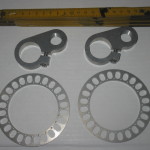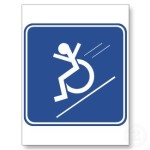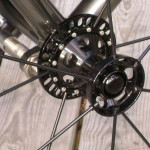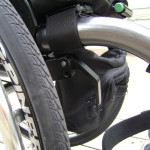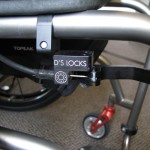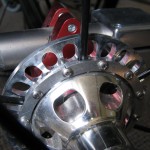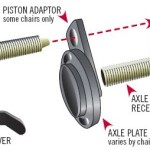What we decided on…
D’s Locks hub locks
D’s Locks are hub locks (brakes) for manual wheelchairs. They take the place of Push-Pull or Scissor style brakes. D’s Locks work independently of the tire by locking the wheel at the hub. Tire types and air pressure no longer matter. With one lever, both of your wheels can be locked securely in place simultaneously, regardless of the tire condition.
Key benefits of D’s Locks
• Single lever positively locks wheels in place
• Locks can can be engaged and disengaged easily, even with limited hand control
• Lockset lever can be mounted almost anywhere for user convenience
• Adds no width to most wheelchairs
• Wheels can be removed and replaced while D’s Locks are engaged
• Compatible with most everyday wheelchairs and wheels
• Simple installation (If you are not mechanically inclined, I would recommend having a dealer install them)
Safety benefits of D’s Locks
It is widely accepted that a large number of wheelchair related injuries occur when individuals in wheelchairs attempt to transfer to or from their wheelchair. Typically, these falls happen when the wheelchair user fails to, or is physically unable to engage the standard wheel locks
With D’s Locks, the danger of wheelchair movement and slippage during transfer is almost entirely removed. They are a basic safety item for the wheelchair to prevent falls from the wheelchair and prevent injury. D’s Locks are durable and secure. Simple operation allows for total control in wheelchair stability, significantly minimizing the inconvenience and threat of injury during transfer associated with the use of standard wheelchair brakes. These safety benefits translate into increased freedom and peace of mind, decreasing the dependence on others.
Standard Composite Push to lock replaced with D’s Locks
The Composite Push to lock’s will go on the upstairs 2GX chair once we have the D’s Locks. They are really nice and light weight.I thought they might be harder to use with one hand, because they are shorter than the aluminum locks with extenders that we have on the 2GX. Because they are so light weight, they are easier to use, and also get in the way less with transfers. This is an overview of all of the TiLite wheel locks:
Initial Review of D’s Locks hub locks
The D’s Locks look to be very nice. We will be getting these black anodized or powder coated now. When we asked about the price to have the manufacturer anodize them we were quoted $250, which seemed very excessive for 4 small parts. The manufacturer did not provide installation instructions, but we have since been in contact and he sent them. I hope to help them update them as I install the D’s Locks.
We got the parts back after being anodized. We had some great help by a local welding shop, who are also friends, in helping us find someone to do such a small amount of parts. In case anyone is curious, the price was €75/$100 and a crate of beer. I kind of screwed up and got the lock rings and adaptors anodized black, but I forgot about the moon shaped pieces. Although I would have preferred them black, I would have then wanted to replace the 52 aluminum screws with black zinc (can’t win!). Probably I am the only one this will bother.
I think I managed to get the D’s Locks installed, and they are working great. I hope to get to a review one of these days.
http://www.dslocks.net http://www.sportaid.com/ds-wheelchair-locks.html
Overview of our requirements
Rob has hemiparesis/hemiplegia — weakness on one side of his body. This means that propulsion of the wheelchair is done with one arm and one leg/foot. He uses his good arm and leg/foot for propulsion (toddling) and steering, but that is hard (think of going in circles).
When he needs to fully lock the brake (think parking brake) for transfers the chair often continues to move because the standard brakes are not strong enough. And he also “neglects” his left side and forgets to engage the brake, which is very dangerous.
On top of that, he has no way to slow down safely if he is descending a ramp. He comes flying down even the ramps inside the house, and the typical exit ramps outside of buildings are pretty much impossible for him. For him to get to the rehab area at the local hospital there is a 10 meter ramp he has to negotiate.
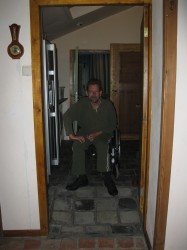
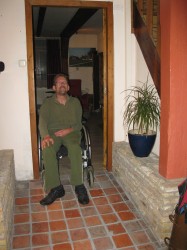
Especially in the stroke community there is a huge need for better solutions for people with hemiparesis/hemiplegia for propulsion, steering, braking and locking. I’ve read a lot about the problems and biomechanics needed, and it’s surprising to me how few options there are. It seems that “most people” are just forced to use power chairs because of it.
Braking
There are also some add-on options for unilateral brakes (one hand braking) for standard push-pull or scissor brakes, but they can not be used to slow down when descending a ramp. Also, these do not “lock” the hub, meaning that they can slip if he is on any type of hill or ramp or while doing transfers, especially if it is wet out.
Grade Aids (or hill holders)
We have also looked into Grade Aids (or hill holders) which are suppose to prevent rolling backward when propelling up ramps and hills, but they do not help with slowing down while going forward, are difficult to use with one hand, and easy to smash your fingers in.
Variable Disc Brakes
We were thinking that it’s better to tackle the braking/locking problem with having a unilateral variable disc brake/lock that simultaneously variably brake and lock both wheel hubs with one hand. From what I’ve seen and others have told me, there is only one product that does this — the ADI Disc Brake System. Here is a video of the ADI disc brake so you can see how it works. After much research we decided against this, due to having to make changes to the camber tube, having concerns about transporting the chair without the wheels on, and the amount of work it was going to take to install and maintain them. We also heard that they do not works so well with the type of wheels that we have, Spinergy LX.
Hub Locks
The last option is a unilateral hub lock (parking brake) like D’s Locks and Surelock’s, These lock the hub with pistons like a (parking brake). They can not be used to slow the wheelchair down on descents (variable braking), but should work for most of what is needed. Here are some pictures:






